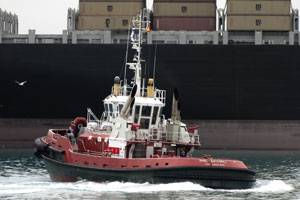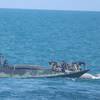First RAstar 3200 Tugs from Robert Allan Ltd.
In late February, 2009, the RAstar 3200 Class tug Monterrey was delivered to the Owners Servicios Marítimos de Baja California, S. de R.L de C.V. of Mexico by the builders Union Naval Valencia (UNV) of Valencia, Spain. Servicios Marítimos de Baja California, S. de R.L de C.V. is a joint venture between Moran Towing of the USA and Grupo Boluda of Spain.
This tug is the first of four expressly designed to work at the Costa Azul LNG terminal on the north-west coast of Mexico, at a terminal exposed to fully developed Pacific swells. The basic requirements for the tug design stipulated that the tug and its winch must be able to sustain a line pull of 75 tonnes throughout the entire terminal approach in a +2 metre significant swell. The resulting winch, described in detail later, is massive and extremely powerful; accordingly it dominated every aspect of the vessel design. In addition, the Owner's required that the entire design be less than 500 GRT, which certainly put a cramp on the intended vessel configuration.
In order to cope with the predominant sea conditions, Robert Allan Ltd. chose to utilize the new RAstar hull form for best sea-keeping. The 500 GRT constraint forced some minor modifications to that concept, and also forced a shortening of the forecastle. The basic hull form reflects the double chine form that characterizes all Robert Allan Ltd. designs, with a sweeping chined stern. A large escort skeg is fitted forward which in conjunction with the sponsoned hull shape enhance the indirect towing capability and provide much enhanced roll stability.
Particulars of the RAstar 3200 Class tugs are as follows:
Length Overall 105 ft
Beam, Moulded 43.3 ft
Depth, Moulded 18.2 ft
Maximum Draft 18.6 ft
Power 4,930 kW
The tug is Classed by ABS:
A1 Towage Service, Escort Vessel, Fi-Fi 1, X AMS, Unrestricted Service.
On trials the vessel performed exceptionally well, achieving a mean Bollard Pull of 82.5 tonnes, and achieved a free-running speed of 14 knots.
Tank capacities are as follows:
Fuel Oil 57,590 gal
Potable Water 6868.5 gal
Engine Lube Oil 528.3 gal
The general layout of the tug is illustrated in the accompanying General Arrangement drawing. The vessel has been outfitted to the highest standards for a crew of six. The main deck features generous cabins for the Master and Chief Engineer, both with en-suite facilities and a spacious crew mess/lounge, served by a fully equipped galley. The lower deck contains two crew rooms, equipped for double occupancy. These two crew rooms share access to a common lavatory space. The remainder of the lower deck space is dedicated to stores spaces and the winch machinery space. The wheelhouse is designed for maximum visibility with a single control station providing maximum visibility to both fore and aft deck working areas. Low noise levels throughout the accommodation and control spaces of the tug are achieved by utilizing advanced methods of isolating main propulsion machinery, as well as high-grade insulation and floating floor techniques.
Main Propulsion for the Monterrey comprises a pair of MTU-16V4000 M71 diesel engines, each rated 2465 kW at 2,000 rpm, and each driving a Rolls Royce model US255 fixed pitch Z-drive unit in ASD configuration, through a Lufkin MV1600S reduction gear and a hollow carbon-fiber intermediate shaft with no line bearings. The combination delivers a static Bollard Pull of 80 tonnes.
The electrical plant comprises four diesel gen-sets, with a 460 volt/3 phase/60 Hz. power output. Two ship's service gen-sets rated 125 kW each are intended for normal operations. When the winch or Fi-Fi systems are operated one of the two large gen-sets, each rated 800 kW are operated. The winch and Fi-Fi generators are configured for parallel operations. The ship service generators are configured for operation on one generator, with the 2nd generator on standby, and the system is provided with an autostart capability that allows automatic start-up of the selected standby generator and connection to the dead bus in the event of a generator failure.
Fire-fighting is to Fi-Fi 1 Class, using electrically-driven Nijhuis pumps and Monitors.
As mentioned, the most distinctive feature of this series of tugs is the main hawser winch on the fore deck. The most obvious difference to a normal ship-handling tug winch is the fact that this winch is arranged in a waterfall configuration. This solution, proposed by Robert Allan Ltd. to the winch manufacturer, put the drums in line, making escort operations through a single staple much easier. The Markey DESDF-48WF winch fitted is claimed by the manufacturer to be the most advanced high-performance Electric hawser winch in the world. This 521 kW winch features dual drums each with a capacity of 200m of 80mm UHMW-PE soft line for use against a Bollard Pull of 75 Tonnes. The unit was designed to perform close escort service in conditions up to Sea State 5 with 3 metre significant wave height with a 14 second wave period. Using Variable-Frequency electric drives, dynamic motor braking and water-cooled disc brakes, this winch is capable of Asymmetric Render/Recover® operation that will maintain constant line tension under such rough sea conditions. The hawser winch is accompanied by a 7.5 KW WEPC-14 anchor windlass and a 15 KW CEP-60 Stern Capstan also by Markey Machinery Co. The aft deck is served by a Large H-Bitt, and a vertical capstan for general line-handling.
Ship-handling fenders at the bow comprise two parallel rows of 900 x 450 cylindrical fenders. 350 x 350 hollow "D" fenders provide protection at the main and foc’sle deck sheer lines, and around the stern.
(www.ral.bc.ca)













